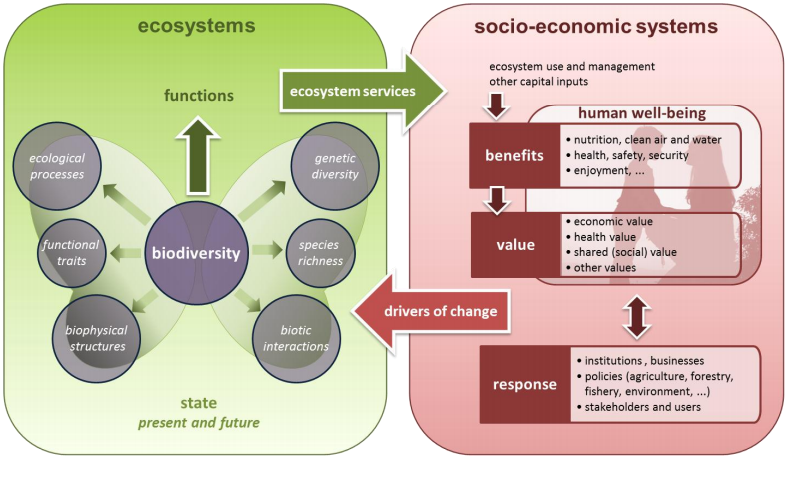Ecosystem Services
Introduction to Ecosystem Services
There are three interlinked concepts related to the provision of ecosystem services, i.e. ecosystem process, ecosystem function, and ecosystem service. Ecosystem process is “any change or reaction which occurs within ecosystems, physical, chemical or biological. Ecosystem processes include decomposition, production, nutrient cycling, and fluxes of nutrients and energy (MA 2005).
The second concept is ecosystem function that is a “subset of the interactions between biophysical structures, biodiversity and ecosystem processes that underpin the capacity of an ecosystem to provide ecosystem services (TEEB 2010).
And finally, ecosystem services are “the benefits that people obtain from ecosystems -the direct and indirect contributions of ecosystems to human wellbeing” (TEEB 2010). The concept “ecosystem goods and services” is synonymous with ecosystem services. The scope of this web-portal is specifically on forest ecosystem services (FES) – those ES provided by forest ecosystems.
Thus the flow of ES is seen as the link between socio-economic systems and ecosystems (MAES 2013), and this is the aspect usually accounted for assessment and valuation of ES. Processes and functions occur inside the ecosystem and are influenced by anthropic drivers that may have an impact (positive and negative) in the provision of services. Biodiversity – the variety of all life on earth – plays a key role in the structural set-up of ecosystems, which is essential to maintaining basic ecosystem processes and supporting ecosystem functions.

Conceptual framework for EU wide ecosystem assessments (MAES, 2013)
People benefit from ecosystem (goods and) services. These benefits are, among others, nutrition, access to clean air and water, health, safety, and enjoyment and they affect (increase) human wellbeing, which is the key target of managing the socio-economic systems. The focus on benefits implies that ecosystem services are open to economic valuation. However, not all benefits to people from ecosystems can be measured in monetary terms. Therefore, it is important to include other values as well, such as health value, social value or conservation value. The governance of the coupled socio-economic-ecological system is an integral part of the framework: Institutions, stakeholders and users of ecosystem services affect ecosystems through direct or indirect drivers of change. Policies concerning natural resource management aim to affect drivers of change to achieve a desired future state of ecosystems. Many other policies also affect these drivers and thus can be added to the framework as they have an impact on ecosystems even though they might not target them at all (e.g. through the construction of buildings or infrastructure, or industrial policy through pollution) (MAES 2013).
It can be stated, the MAES (2013) framework is successful in integrating the biophysical domain with the socio-economic drivers affecting ES and considers as well the role of biodiversity in ecosystem functions and services, therefore this is a good basis for consideration of European forests in terms of ecosystem service delivery and opportunity.
Classification of Ecosystem Services
Several classification approaches to classification of ecosystem services has been developed. MAES, according to Common International Classification of Ecosystem Services (CICES, 2013), classifies ES into three groups: Provisioning, Regulating/Maintenance and Cultural services. However, there are also other two international classifications of ES applied according to MA (2005) and TEEB initiatives (2010).
Comparison of these three main classification schemes was addressed by the FOREST EUROPE Expert Group on Valuation of Forest Ecosystem Services during 2013-2014, and the results can be found in the FOREST EUROPE Final Report on Valuation of Forest ecosystem Services (2014).
Further reading:
- Haines-Young, R.; Potschin, M. (2013): Common International Classification of Ecosystem Services (CICES): Consultation on Version 4, August-December 2012. EEA Framework Contract No EEA/IEA/09/003
- MA (2005): Ecosystems and human well-being: biodiversity synthesis. Washington, D.C. (USA): World Resources Institute.
- MAES (2013): Mapping and Assessment of Ecosystems and their Services – An analytical framework for ecosystem assessments under Action 5 of the EU Biodiversity Strategy to 2020. Luxembourg: Publications office of the European Union.
- MAES (2014): Mapping and Assessment of Ecosystems and their Services – Indicators for ecosystem assessments under Action 5 of the EU Biodiversity Strategy to 2020. Luxembourg: Publications office of the European Union.
- TEEB (2010): The Economics of Ecosystems and Biodiversity: Ecological and economic foundation. Cambridge: Earthscan.